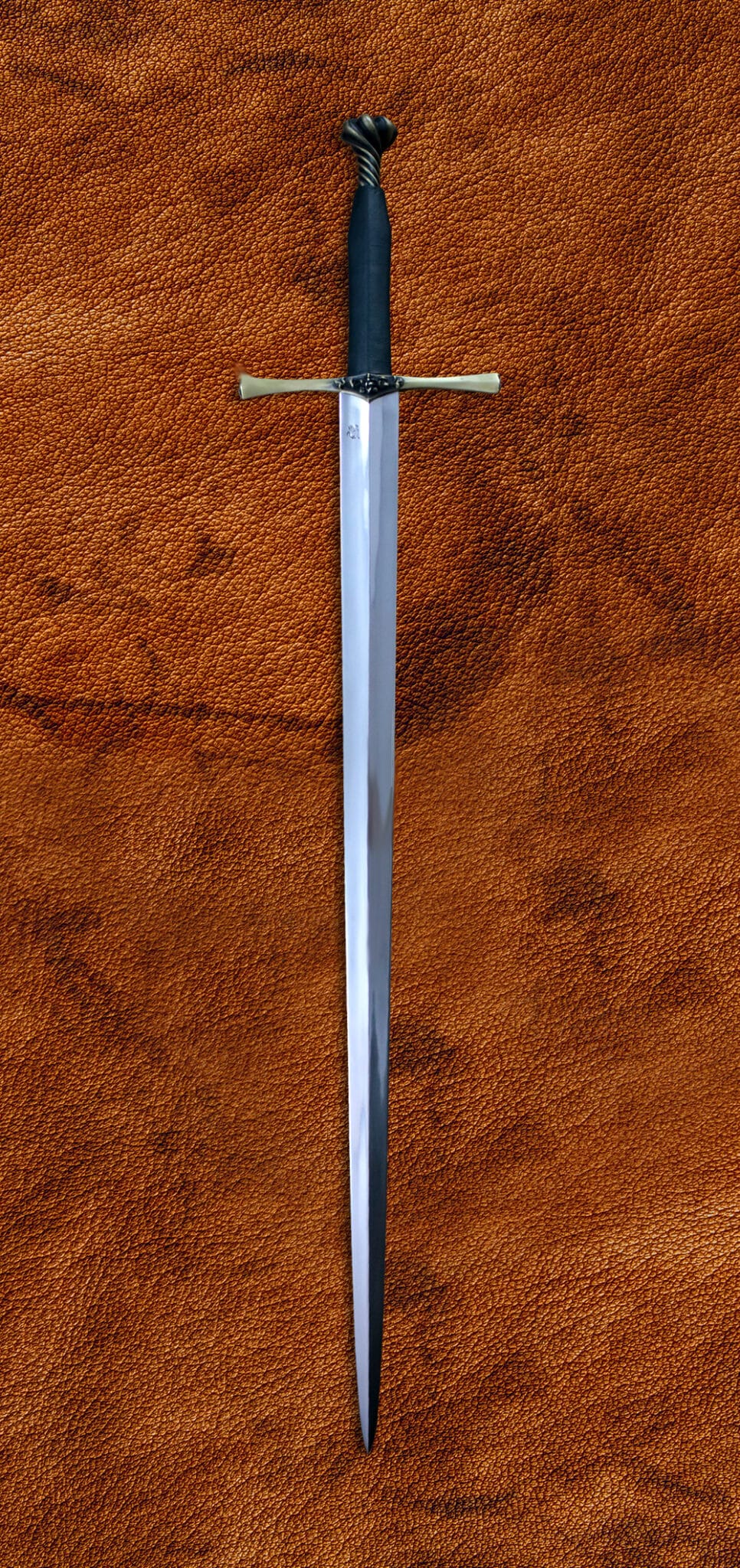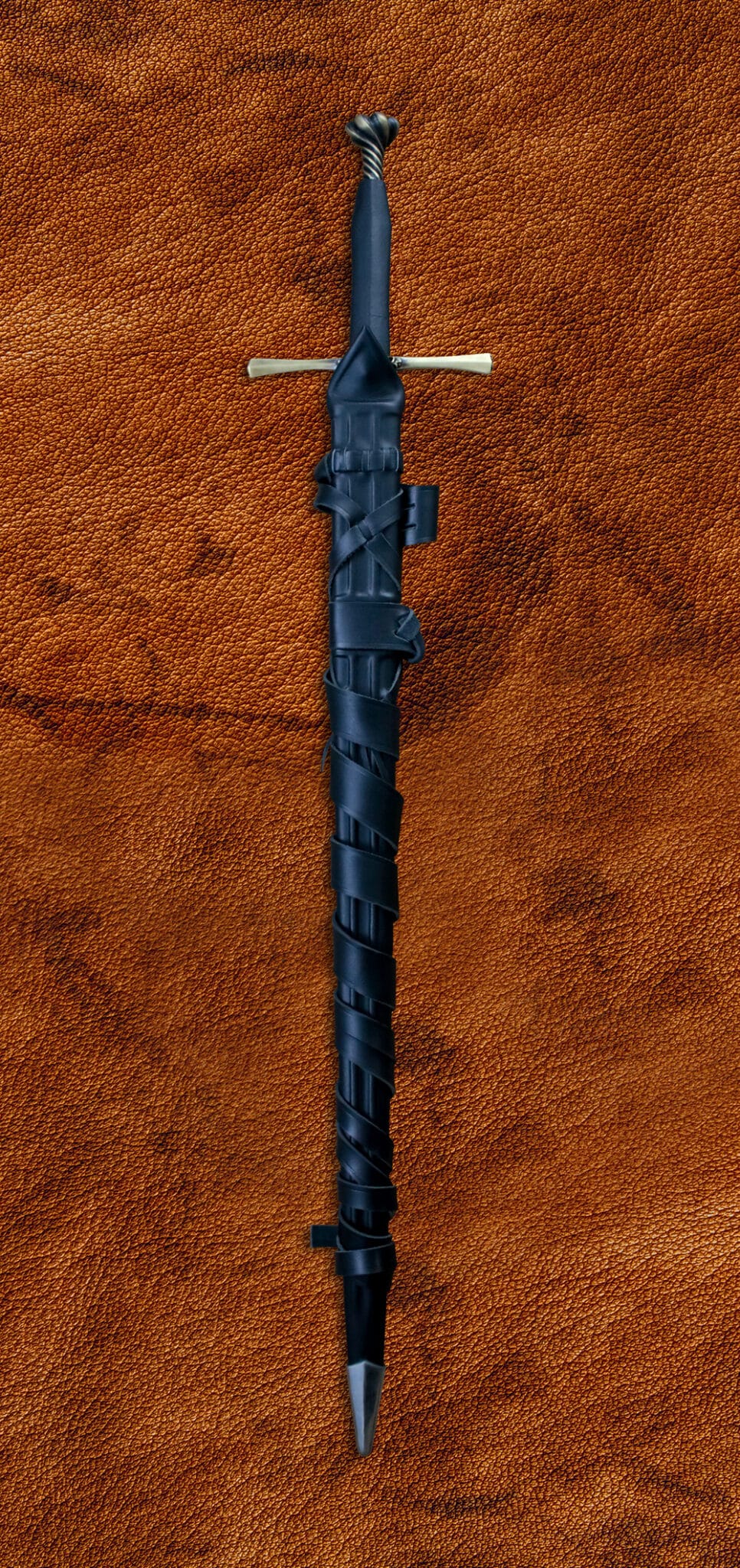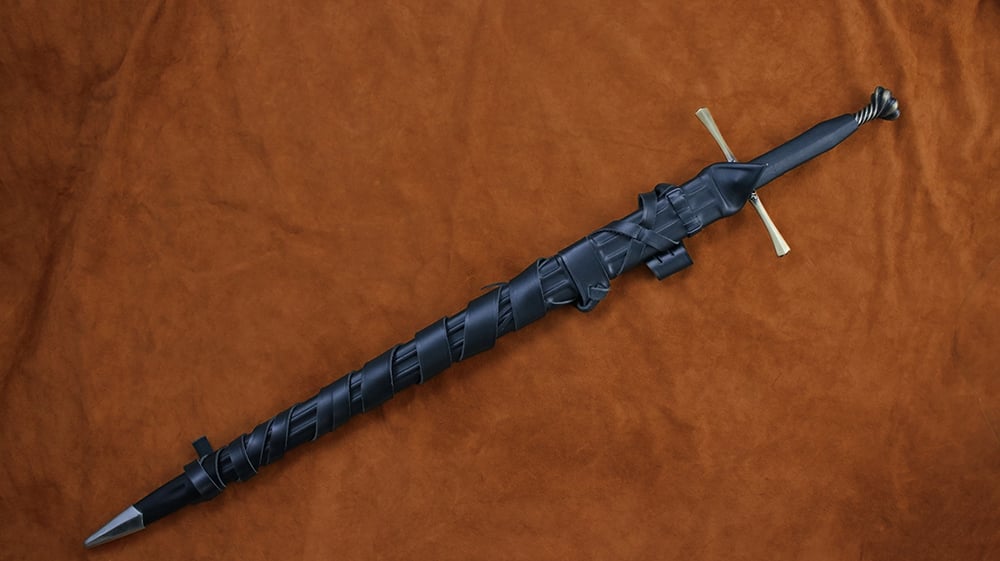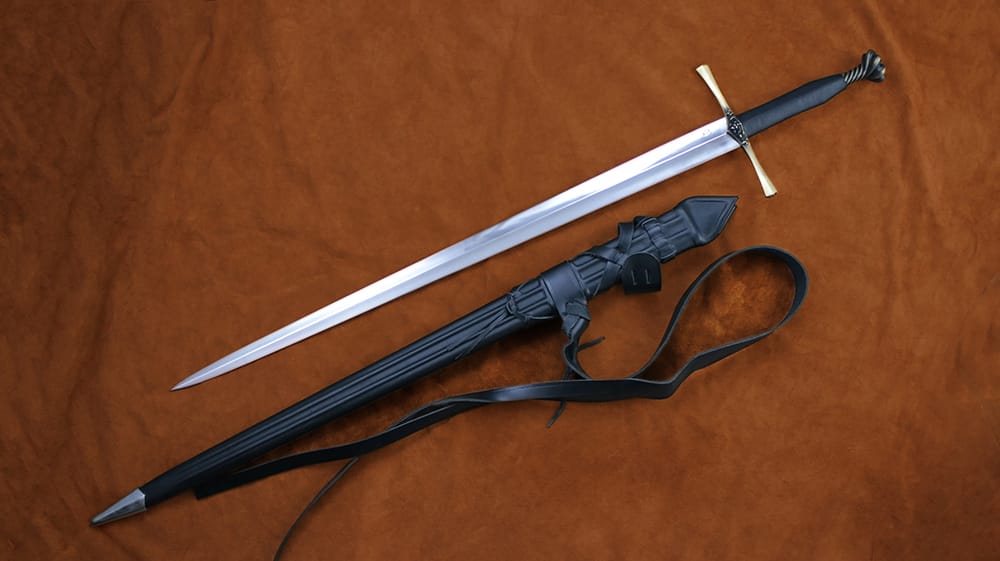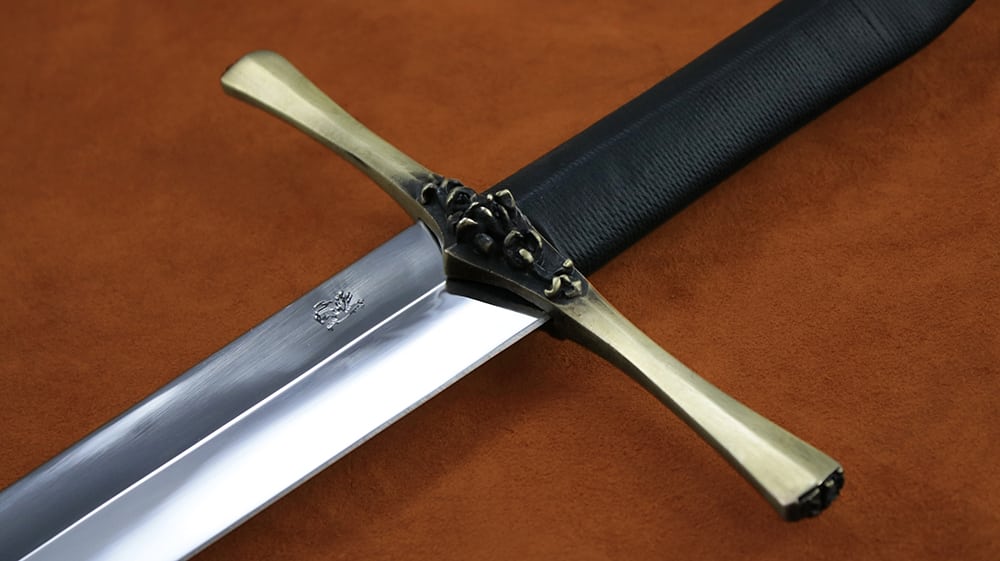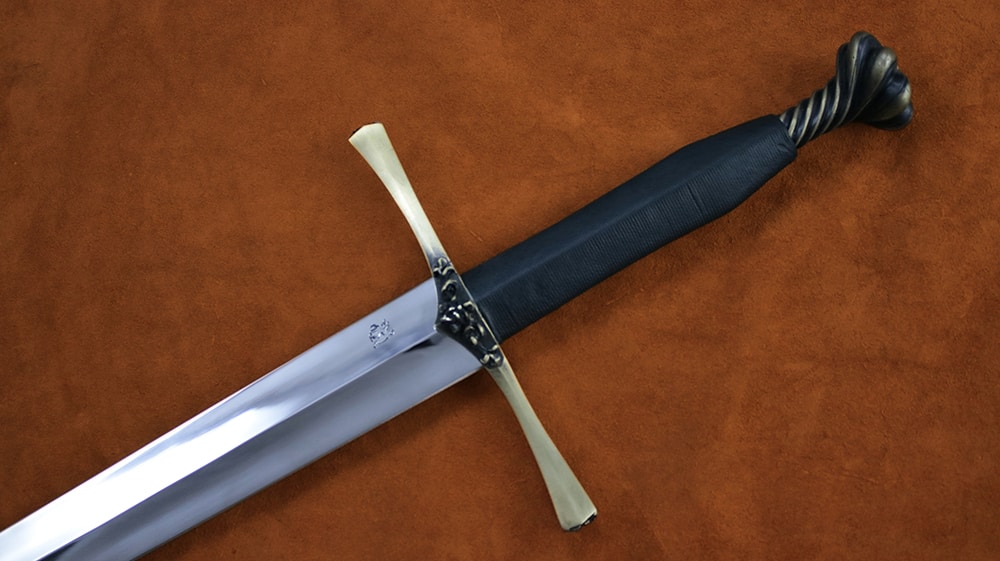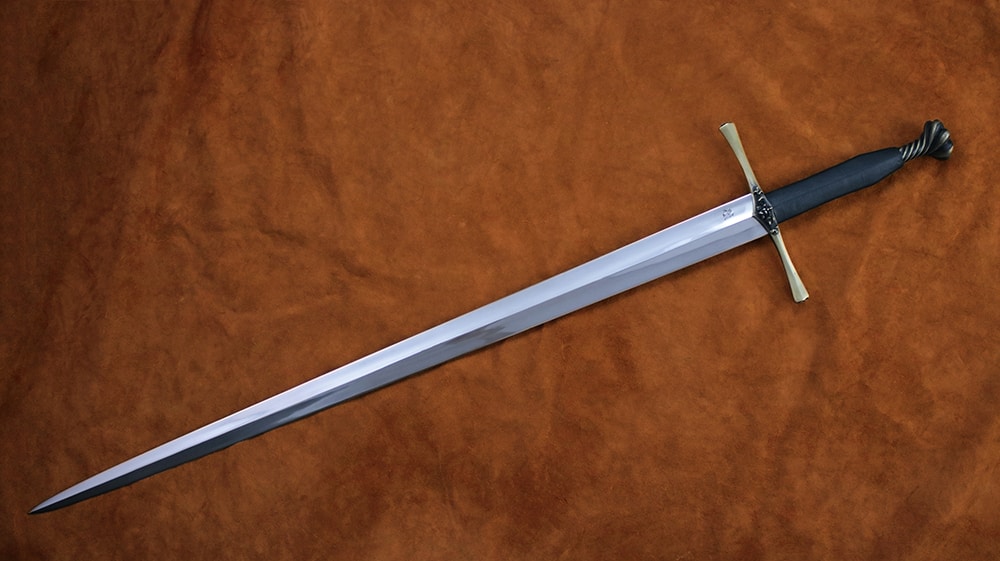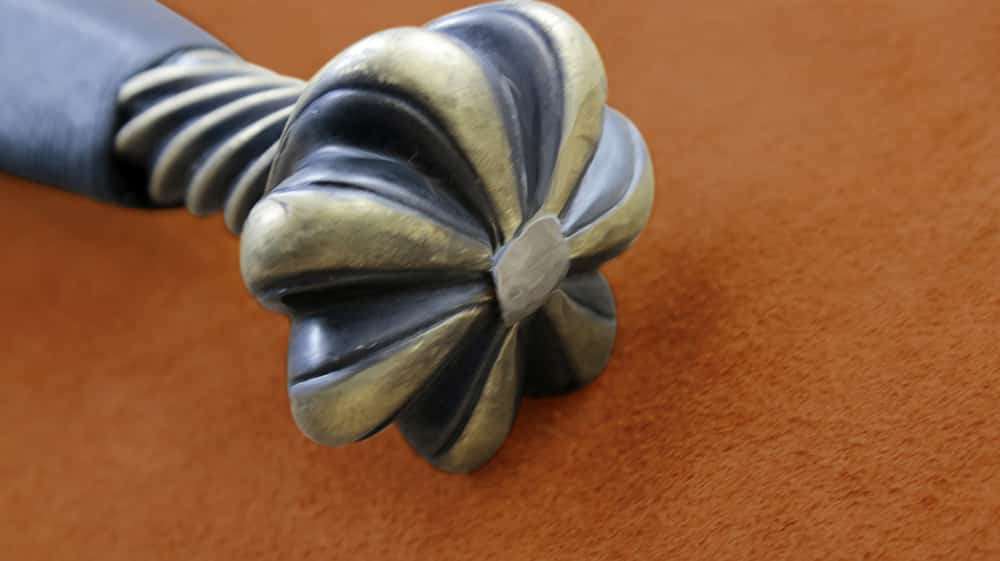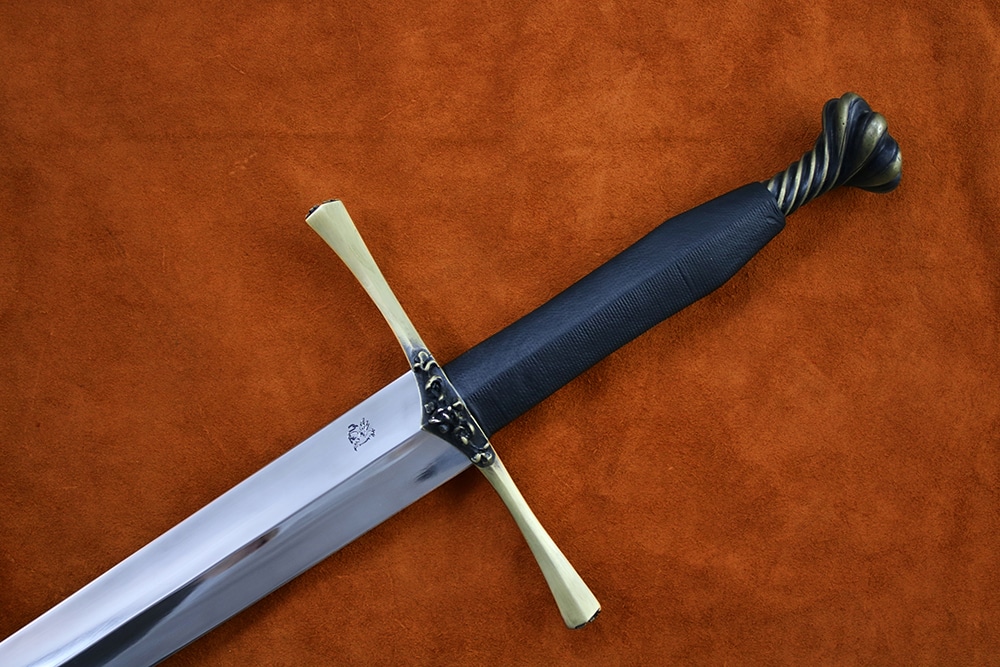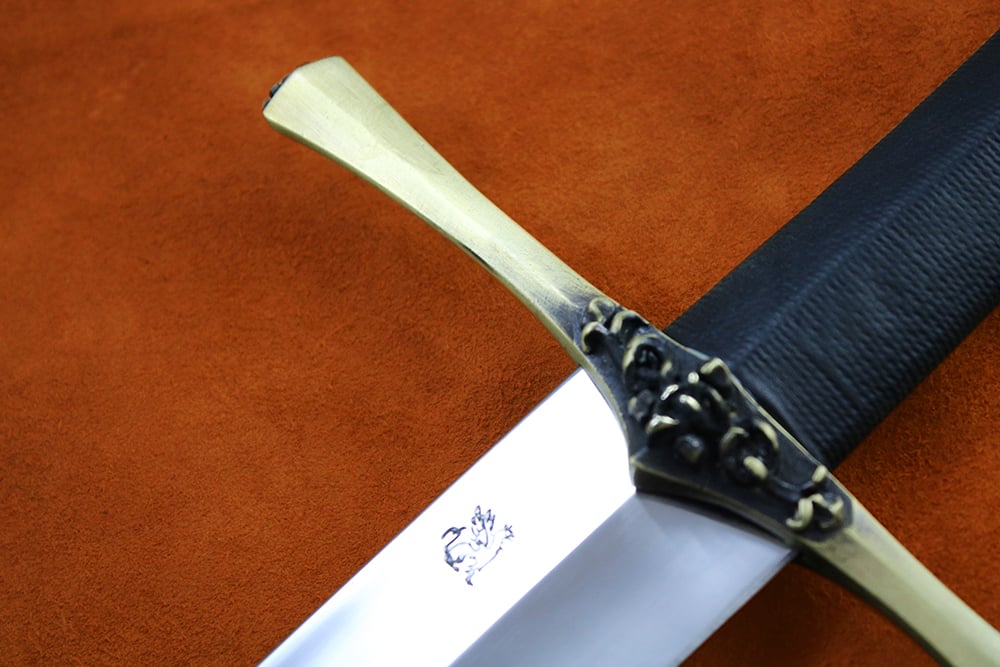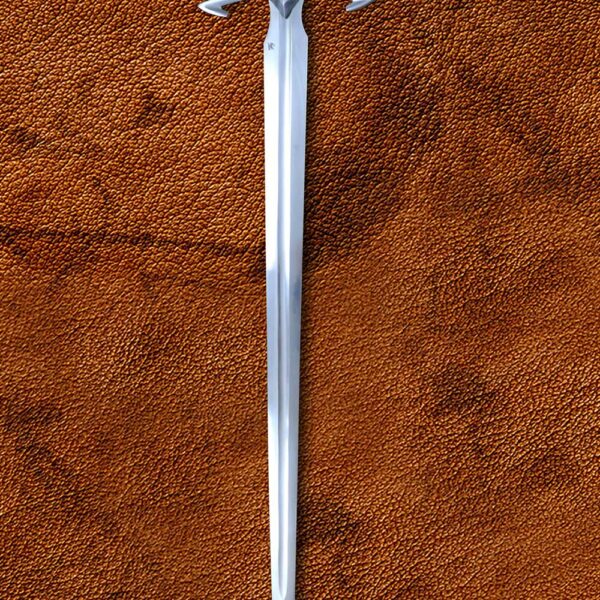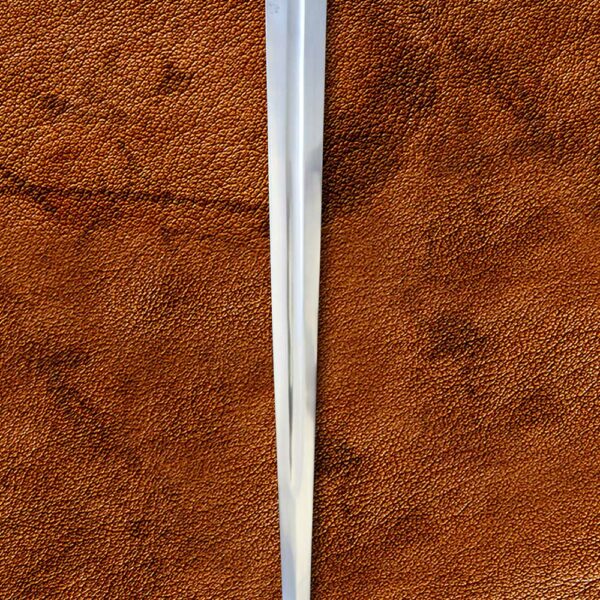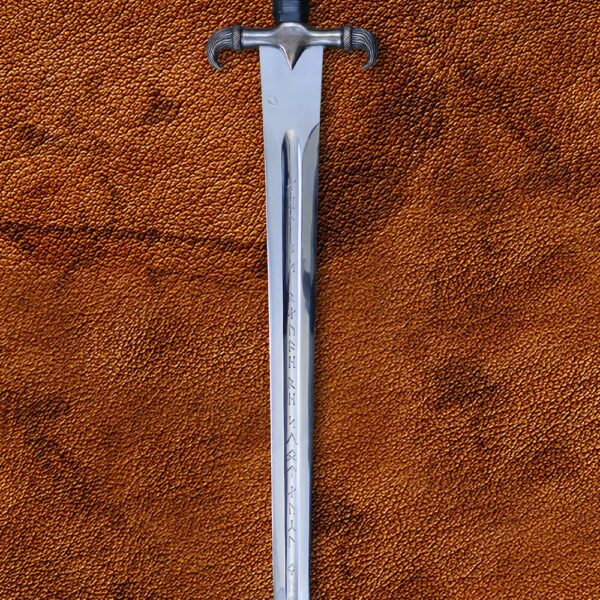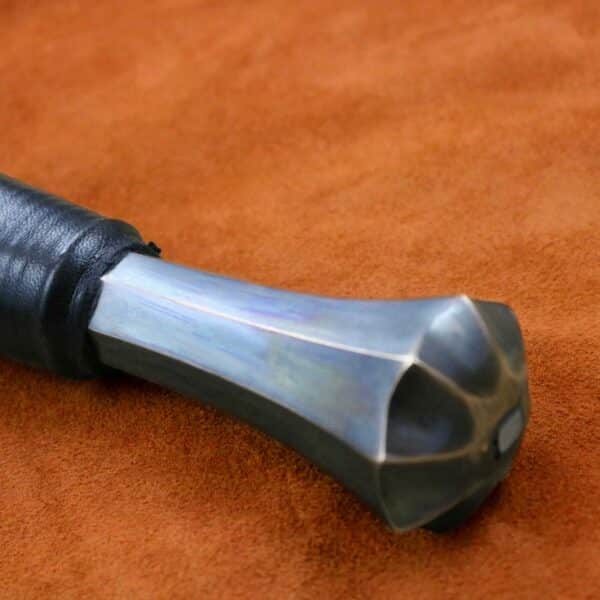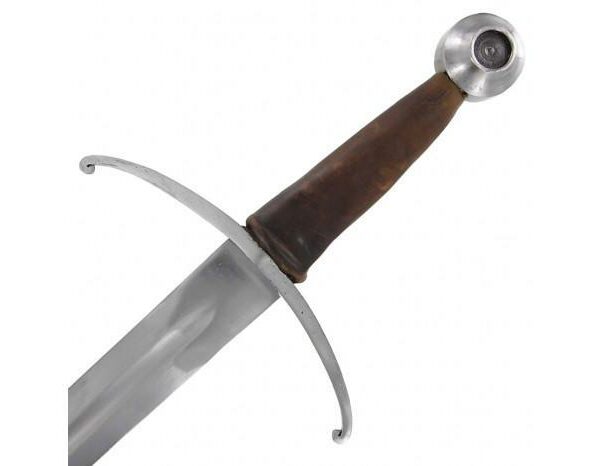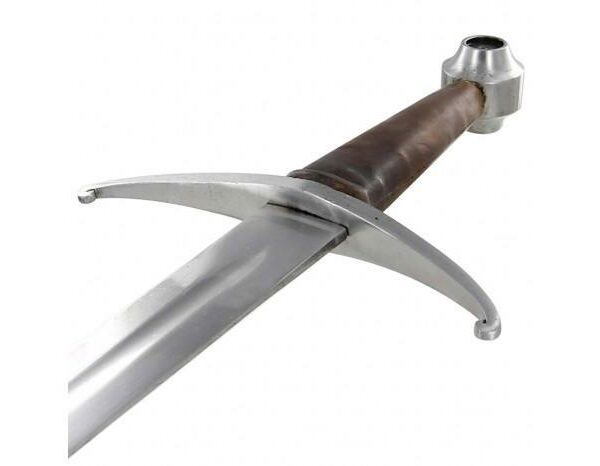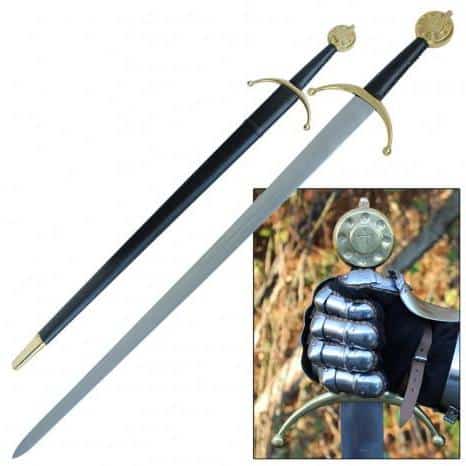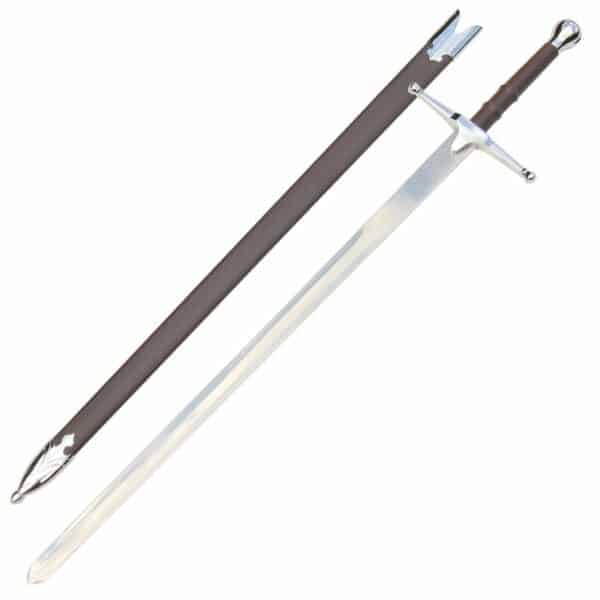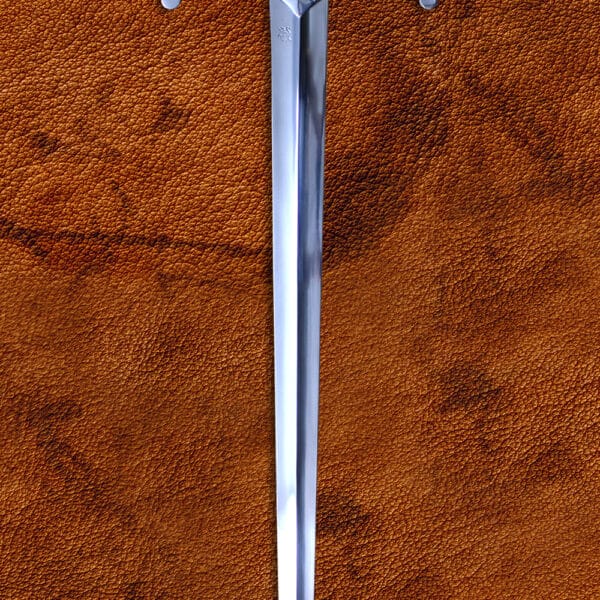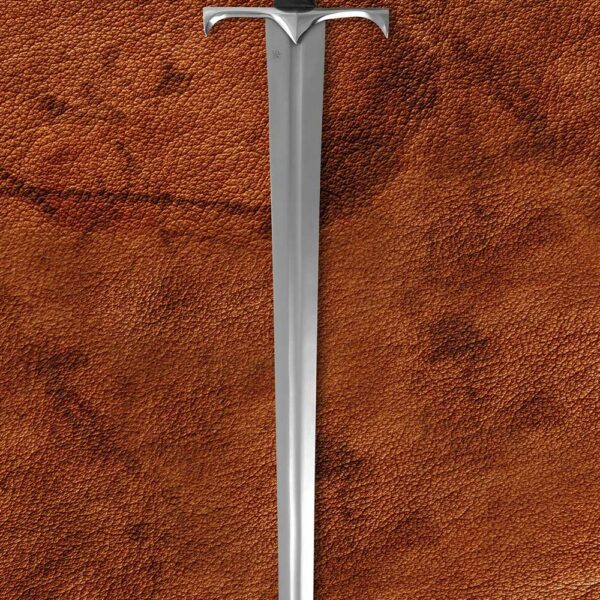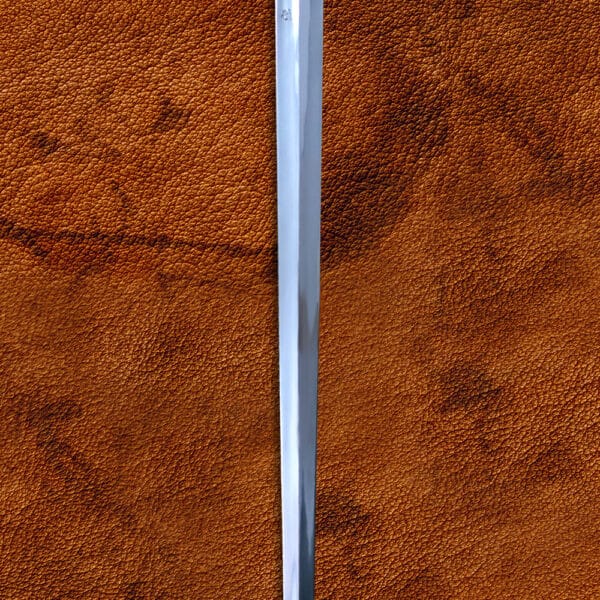The Sovereign Renaissance Sword
(About): The Sword, Reborn: A Rebirth of a Classic Design, Looking Towards the Modern World
We might imagine that the invention of plate armor rendered arming swords all-but-useless, leaving only room for enormous weapons like the pole-axe or halberd. The reality is far more complex: late-medieval soldiers continued to wear a motley assortment of armor, from the latest plate armor (if they could afford it), to ‘transitional’ forms of armor like splint-mail and brigandines, all the way down to simply a few scavenged pieces or ordinary stout clothes. Thus, swords absolutely needed to become cleverer – but they were by no means an irrelevance. The cut-and-thrust swords of the Renaissance era were a response to these new forms of armor and fighting. They were narrower and stiffer than their High Medieval forebears, but they were unmistakably chivalric in origin and construction, melding the past and the future of warfare between the Crusader sword and the rapier.
Legendary sword-smith Bruce Brookheart joined the Darksword Armory workshop to co-design our Sovereign Renaissance Sword, a gorgeous Late Medieval weapon, featuring a Type XV blade, cast-bronze guard and scent-stopper pommel.
A Glorious Type XV Blade, Meticulously Hollow-Ground by Master Smiths
The blade of our Sovereign Renaissance Sword conforms to a late-15th-century Oakeshott Type XV. These swords have been made with a diamond-cross section, resulting in a stiff sword extremely well-suited to thrusting, but the four faces of the sword have been heavily ground out to form concave curves, a laborious process called ‘hollow-grinding’. Many a similar Renaissance festival sword for sale forgoes this process, whose makers evidently thought that the diamond cross-section was ‘close enough’. The reason for this process is obvious as soon as one picks up the blade: it reduces the weight of the blade significantly, bringing the point of balance in close to the hilt, making it lightning-fast and agile. It can be conceived of as a sort of inverse fuller, without compromising the rigidity of the blade, and thus its puncturing power. Our Sovereign Renaissance Sword displays the typical form of this blade, as Oakeshott puts it. “so strongly hollowed out that a nearly flat blade with a powerful upstanding mid-rib results”. Yet at the same time, its edges clearly demonstrate its design for thrusting: the edges do not taper that significantly until the final quarter of the blade, and the point is significant but not extreme. Thus, we can categorise this as a typical ‘cut-and-thrust’ sword that we have described above.
Darksword Armory’s smiths have forged this blade from 5160 stainless spring steel, a magnificent sword steel that has been tested being bent through 90º (!) before returning to exact true. It has also been dual-tempered, like all of Darksword’s incredible weapons, with a resulting hardness of 60 HRc at the edge and 48-50 HRc at the core, exhibiting fantastic edge-retention and a flexible tough core for a brilliant battle-ready blade.
A Composite Hilt Combining the Finest Styles from Renaissance Europe
The hilt of our Sovereign Renaissance Sword is a tour-de-force of historical reproduction. Working from surviving German and French swords from the period, Bruce Brookheart and Darksword’s in-house designers have created a historically-faithful composite unlike any sword before or since. The cross-guard is cast in polished solid-bronze, and features slightly flared quillons as to better control an opponent’s blade, as well as a gorgeous original French floral motif which has been cast in magnificent detail by the bronze. The grip is a handsome stepped hand-and-a-half with a diamond profile, wrapped with fine leather – not only does this continue the diamond-cross section of the blade into a unifying motif, it also provides an excellent grip surface which will not turn in the hand during use. The pommel is another secret nod towards the heritage of this blade: it has actually been cast from the pommel of a 15th-century CE kalzbalger sword in Darksword Armory founder Eyal Azerad’s personal collection! (What we at Medieval Ware wouldn’t give to browse that particular cave of wonders…) Our Sovereign Renaissance Sword’s pommel is a stunning twisted ‘scent-stopper’ shape, and it has been carefully weighted to give this cut-and-thrust sword a balance point suited to staggeringly fast cuts and accurate thrusts. This sword has been constructed with a full, peened tang – the hilt components have been threaded onto the blade’s keyed tang, and the end has been hammered flat to secure it all firmly in place. This means that this sword is a re-enactment-grade, fully battle-ready weapon that will perform admirably against other blades of similar hardness in light combat, as well as rolling with the rigors of re-enactment and roleplay.
(History): The Sword In the European Renaissance
The European Renaissance is nearly impossible to summarise in a handful of words, but it is a vital concept for understanding the transition from medieval, feudal theocracy to modern, capitalistic humanism. It is vital to understand that, before the Renaissance, Europe was an economically-stunted, culturally-backward poorer-relation of the flourishing empires in the Middle East. The factors which drove the intellectual and cultural flowering that flowed outward from Italy from the 14th-century CE were due in large part to their interaction with the East – without this key interchange, it seems unlikely that it would have taken on the specific form of a ‘rediscovery’ of Classical heritage. Muslim scholars were custodians of many Greek texts on mathematics, astronomy and physiology, which had come into the possession of Eastern empires during Late Antiquity. Their additions to these texts formed the basis of an enormous corpus of knowledge, which found fertile soil in the permissive atmospheres and loosened feudal bonds of the Italian city-states. Later waves of scholarly interplay, such as the émigré Greek scholars who moved to the Italian peninsula after the Ottoman conquest of Constantinople in 1453 further spurred this rich dynamo. And amidst the turmoil generated by this upheaval in ideas and how classes related to one another, warfare began to change.
Renaissance Warfare
By the high-point of the Italian Renaissance in the 15th-century CE, warfare was fundamentally different to how it had been a century earlier. Now, plate armor and densely-ranked pike infantry were the order of the day, with the forerunners of the cannon beginning to make an appearance. Mercenaries began to become dominant in the process of fighting warfare – extreme examples include the condottieri of Italy, groups of whom would be hired by contending rivals to enact near-ritualised battles for martial supremacy. Even the appearance of battlefields shifted fundamentally. Where before, tall towers and imposing curtain-walls marked out a fortification, now star-forts, cannon emplacements and deflecting glacis embankments faced attacking troops. Amidst this alien landscape, the chivalric knight on horseback, wielding a lance and arming sword, might seem an absurd anachronism. Yet chivalric, Christian ideals, and the arming sword which bore them all in one cruciform object, was still the marker of nobility, perhaps all the more because of its stability as a fixed point amid the rapidly evolving world around it.
Renaissance Steel
This is not to say that the arming sword remained unchanged, a useless relic merely symbolically wielded. The Renaissance saw an enormous amount of innovation in the realm of sword manufacture, not least because of the significantly easier availability of steel – first from improvements in simple bloomery technology, and then, as mechanical technologies improved, blast furnaces and ‘fining’ processes. By the early 1400s CE, iron furnaces were approaching industrial scale – for example, a furnace found at Ferriere di Val Nure near Piacenza dating from 1463 is over 15 ft (4.5m) in height, and would have gotten hot enough to liquefy iron and drive out its impurities, creating cast iron which could be ‘fined’ into extremely high-quality carbon steel. Water power and greater control over the processes meant that, rather than relying haphazardly on environmental factors, metallurgists now had a significant degree of control over the production of metals, be it iron blooms, steel blooms or cast iron, by scientifically influencing the conditions within these enormous furnaces. Thus, although the rare ‘Damascus steel’ made in crucibles in South India likely remained the best sword-making material available even well into the Late Middle Ages, Renaissance sword-makers now had access to very good steels made domestically or at least freely available on the open market.
Thus, the knightly arming sword, evolving in a straight line from the Roman spatha via the Carolingian ‘Viking Age’ sword and the Norman cavalry sword, continued on, marching straight into the mouths of cannon and the smoke of the gunpowder age. Our Sovereign Renaissance Sword represents its last hurrah – and its finest hour.
Complete the kit! Check out this Helmet and this Cuirass!
Technical Specifications:
- Total length: 41 inches
- Blade length: 32 inches
- Blade width: 2 inches
- Blade material: 5160 carbon steel
- Blade hardness: 60 HRc at edge ; 48-50 HRc at core
- Guard and pommel material: Solid bronze
- Grip material: Leather
- Weight: 2 lbs.

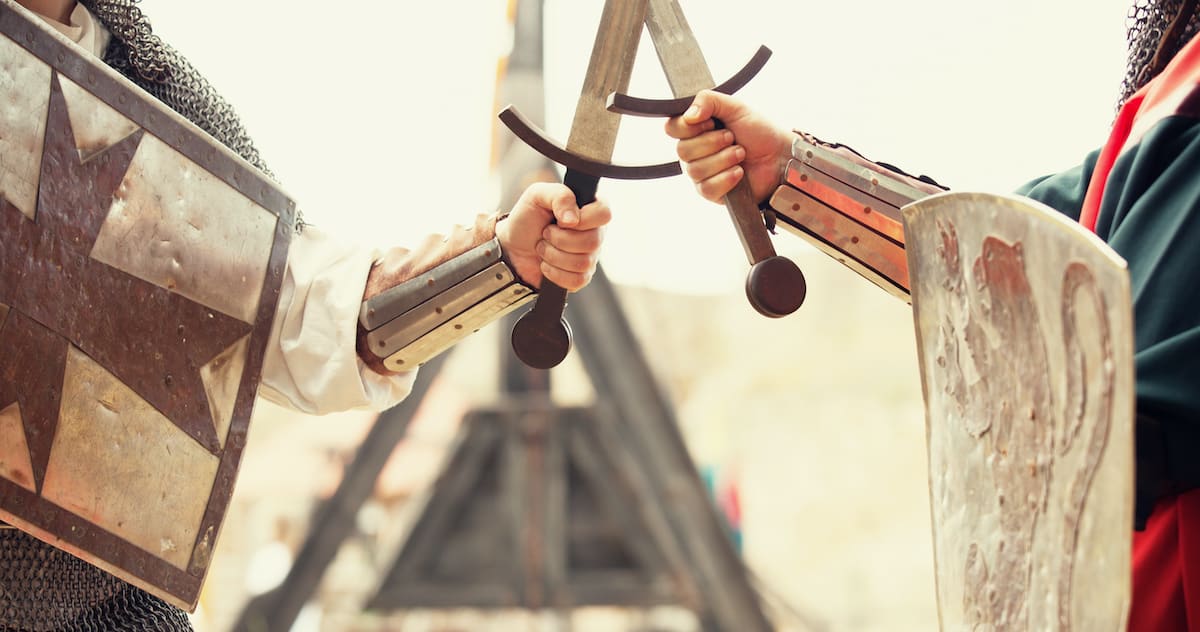 Historical Swords
Historical Swords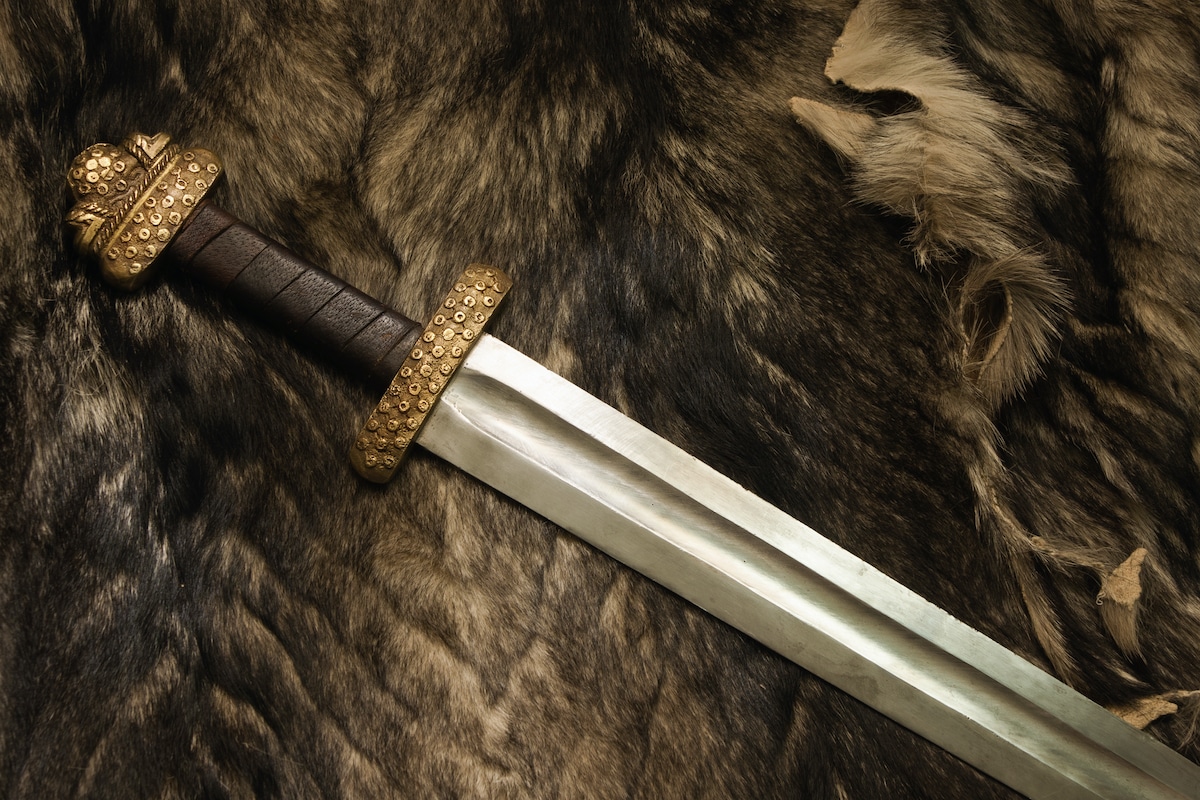 Norse & Viking Swords
Norse & Viking Swords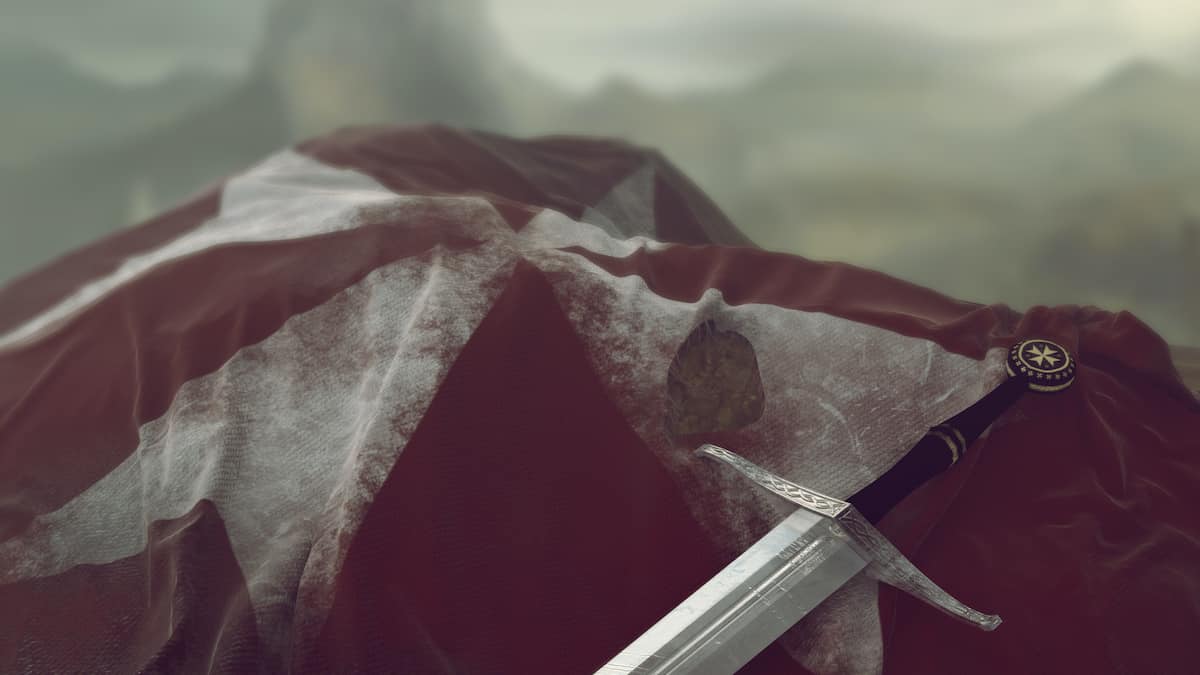 Templar Swords
Templar Swords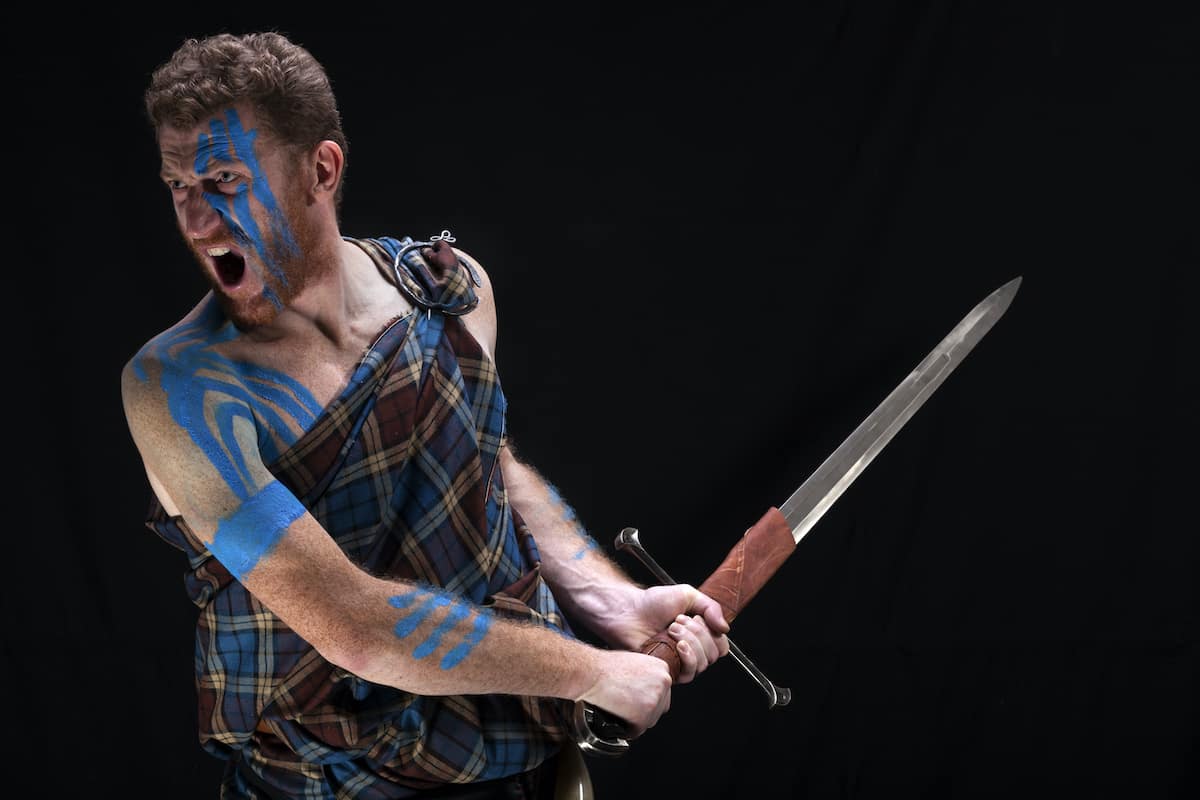 Claymore Swords
Claymore Swords Fantasy Swords
Fantasy Swords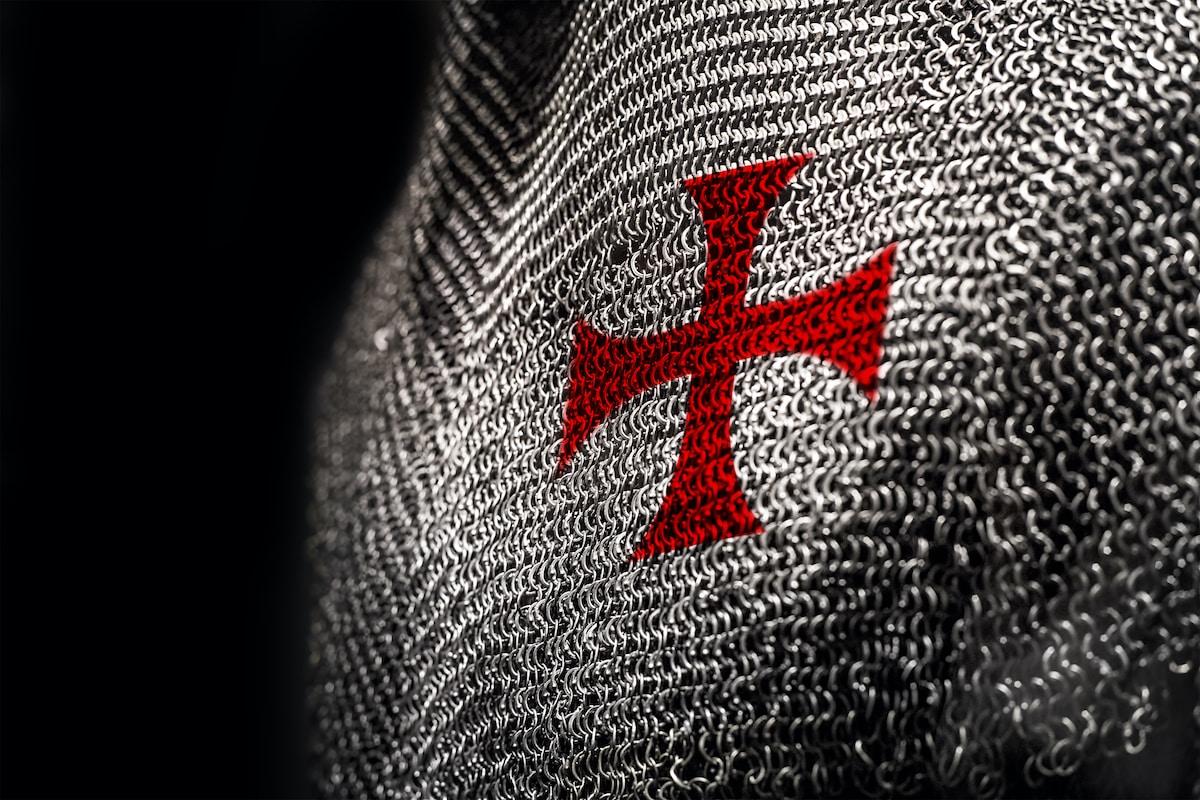 Chainmail
Chainmail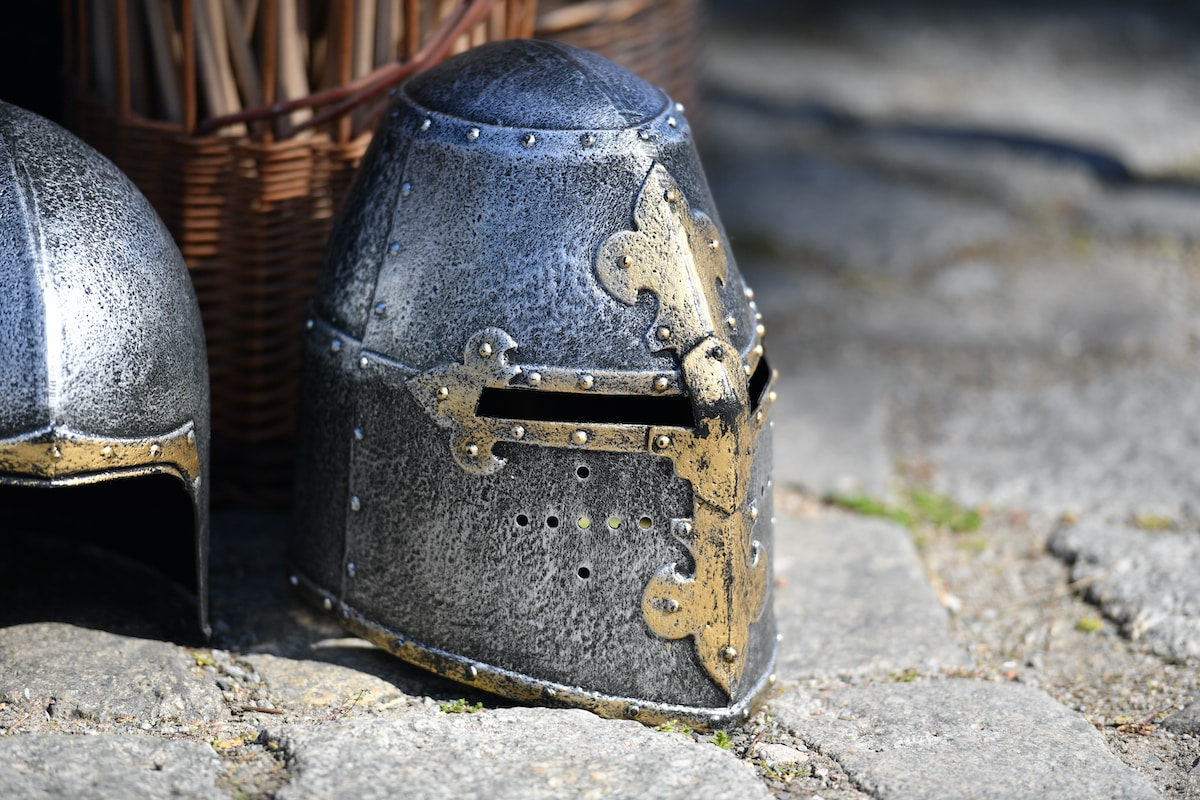 Helmets
Helmets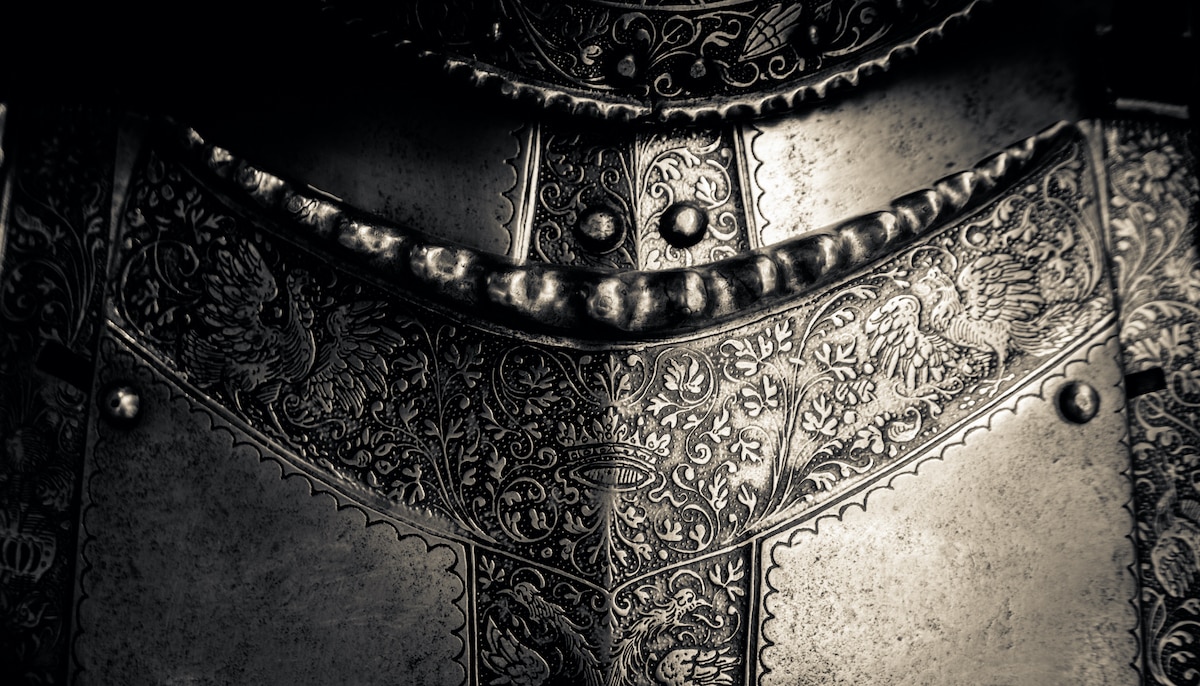 Torso Armor
Torso Armor Bracers and Arm Protection
Bracers and Arm Protection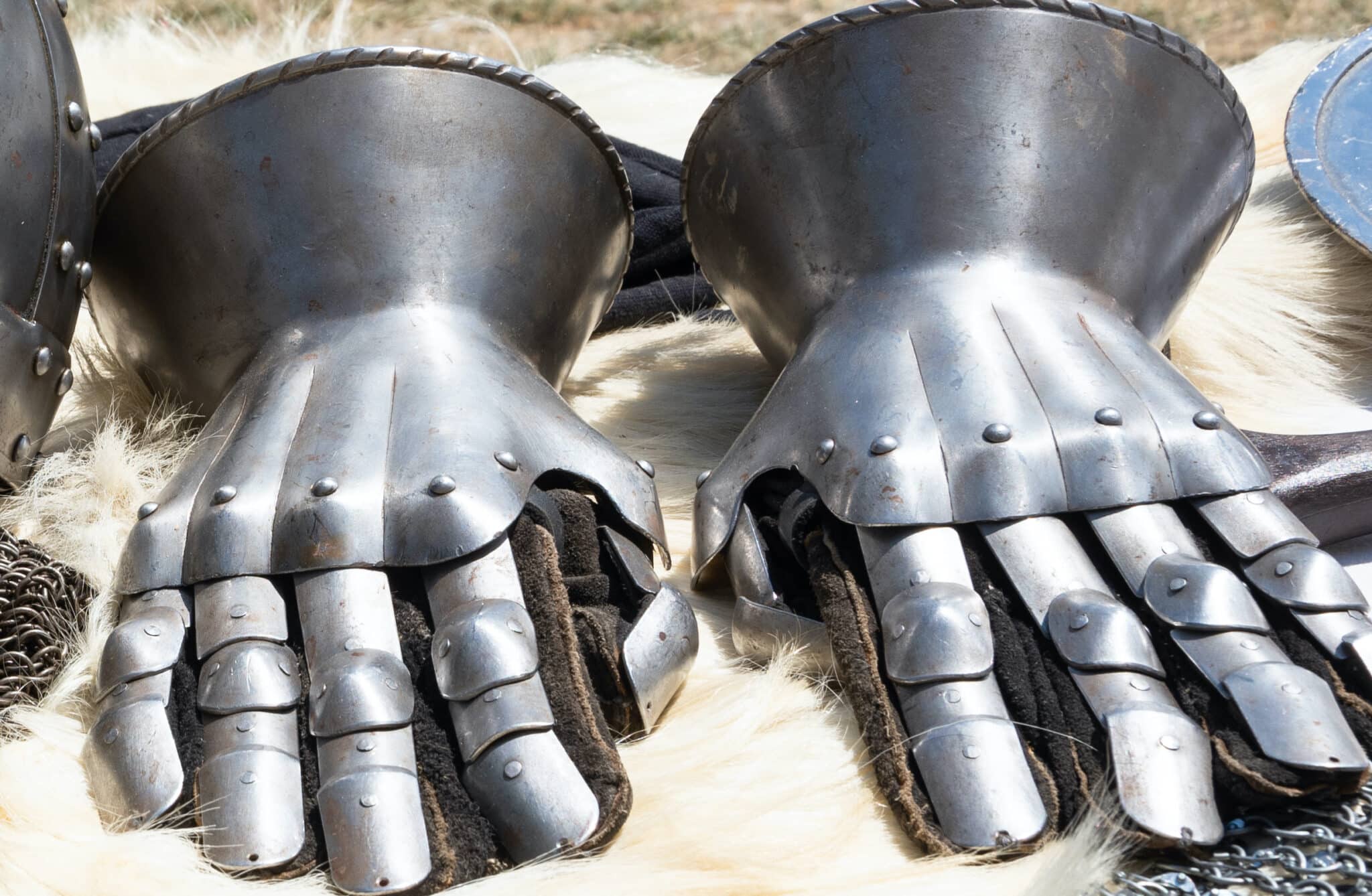 Gauntlets
Gauntlets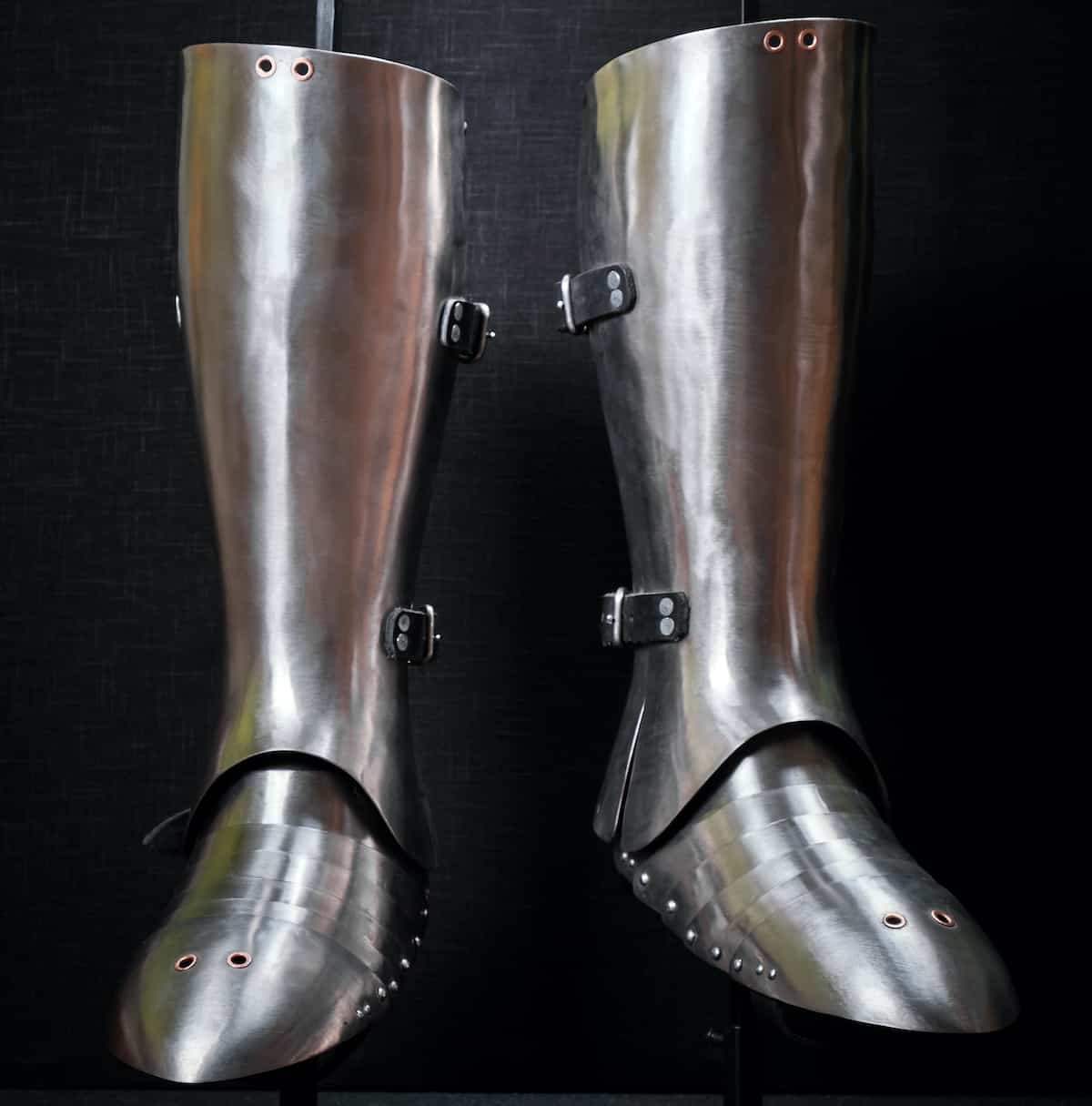 Leg Armor
Leg Armor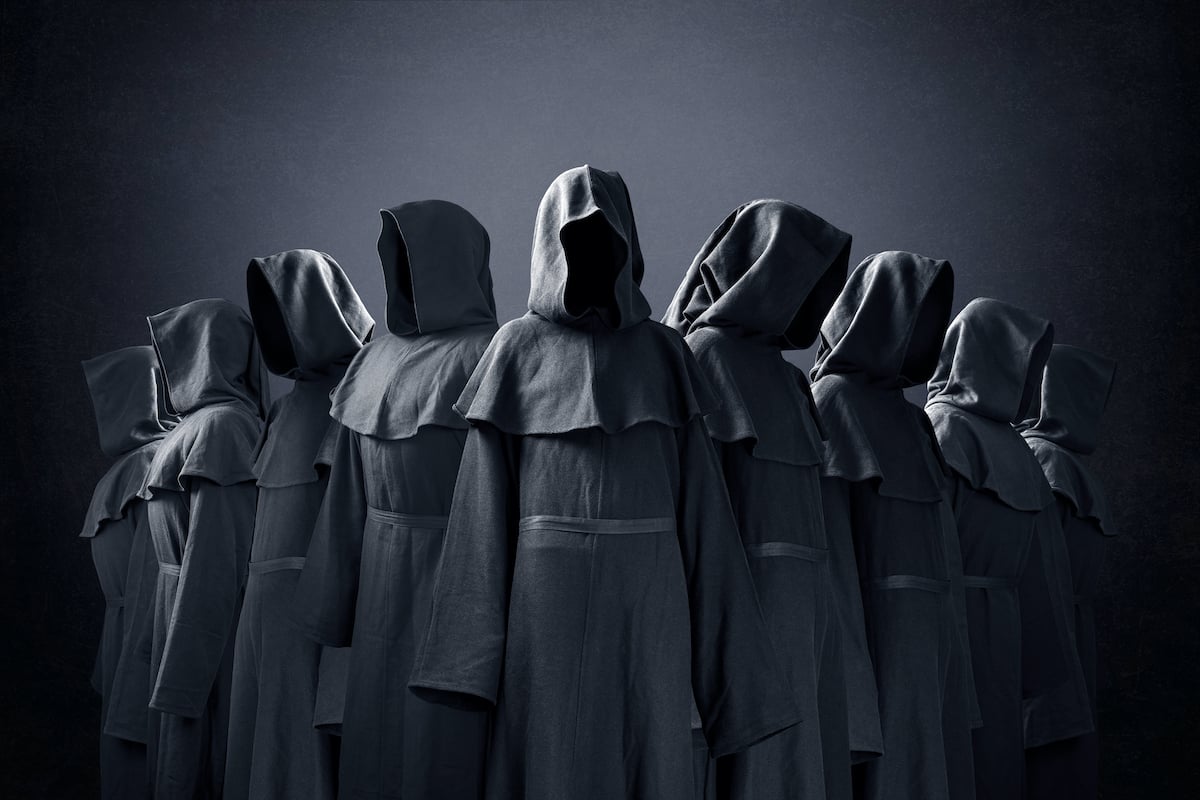 Cloaks
Cloaks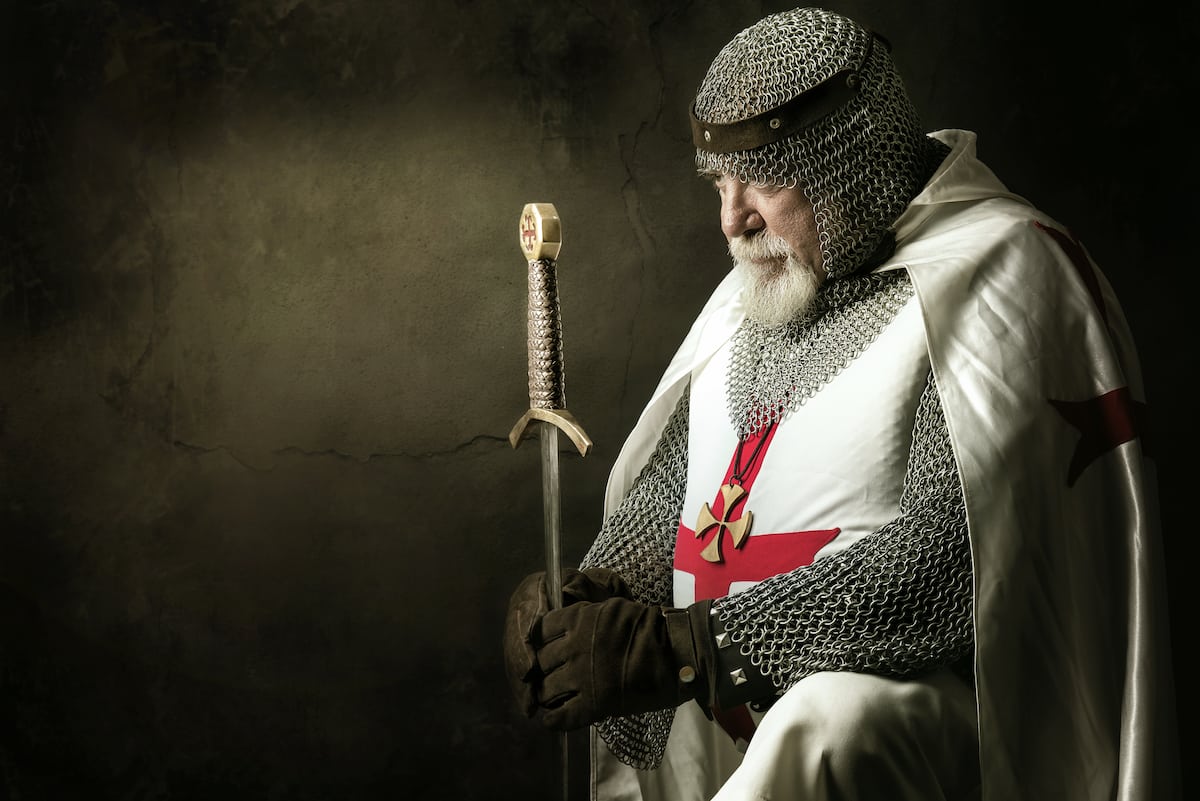 Tabards
Tabards Shirts
Shirts Tunics
Tunics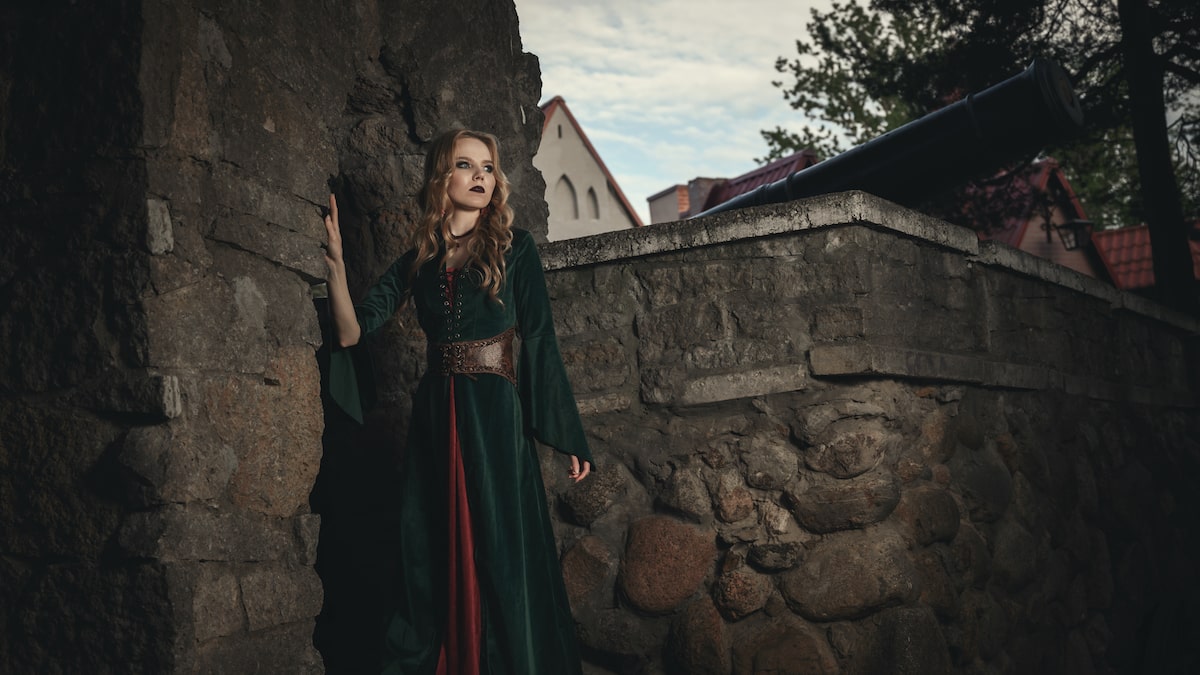 Dresses
Dresses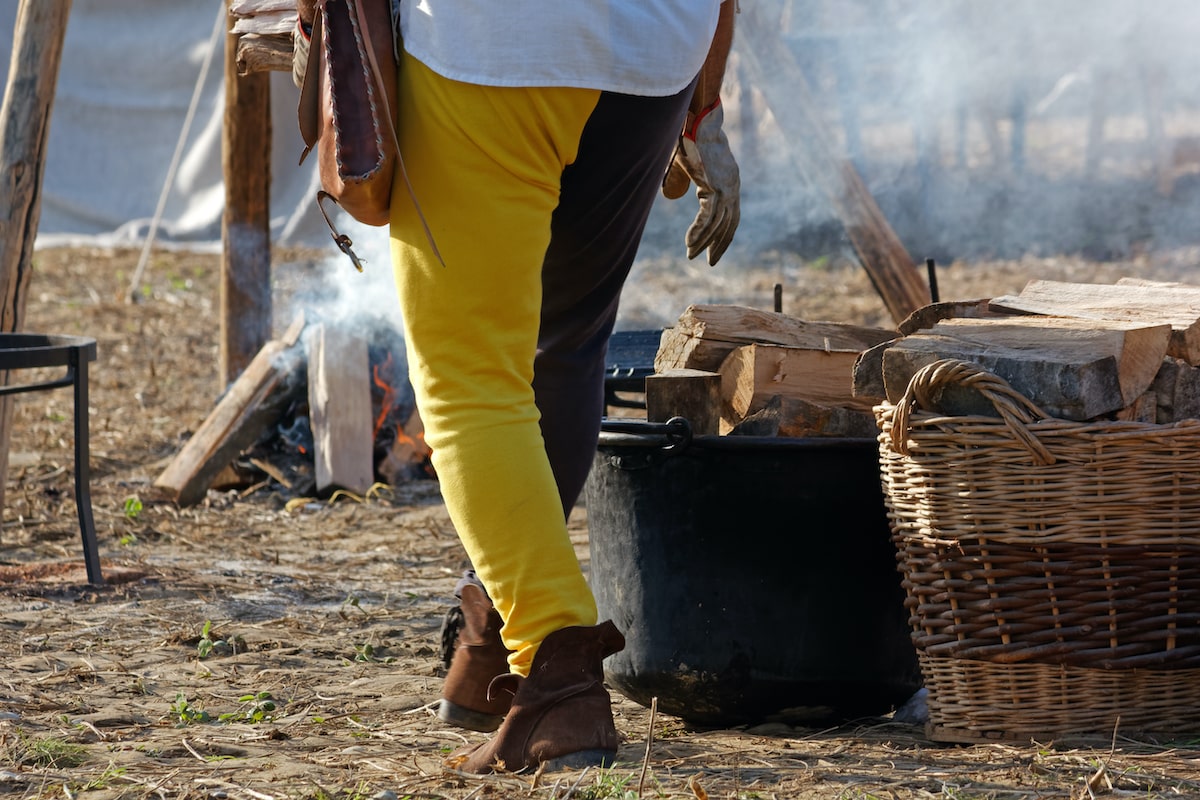 Pants
Pants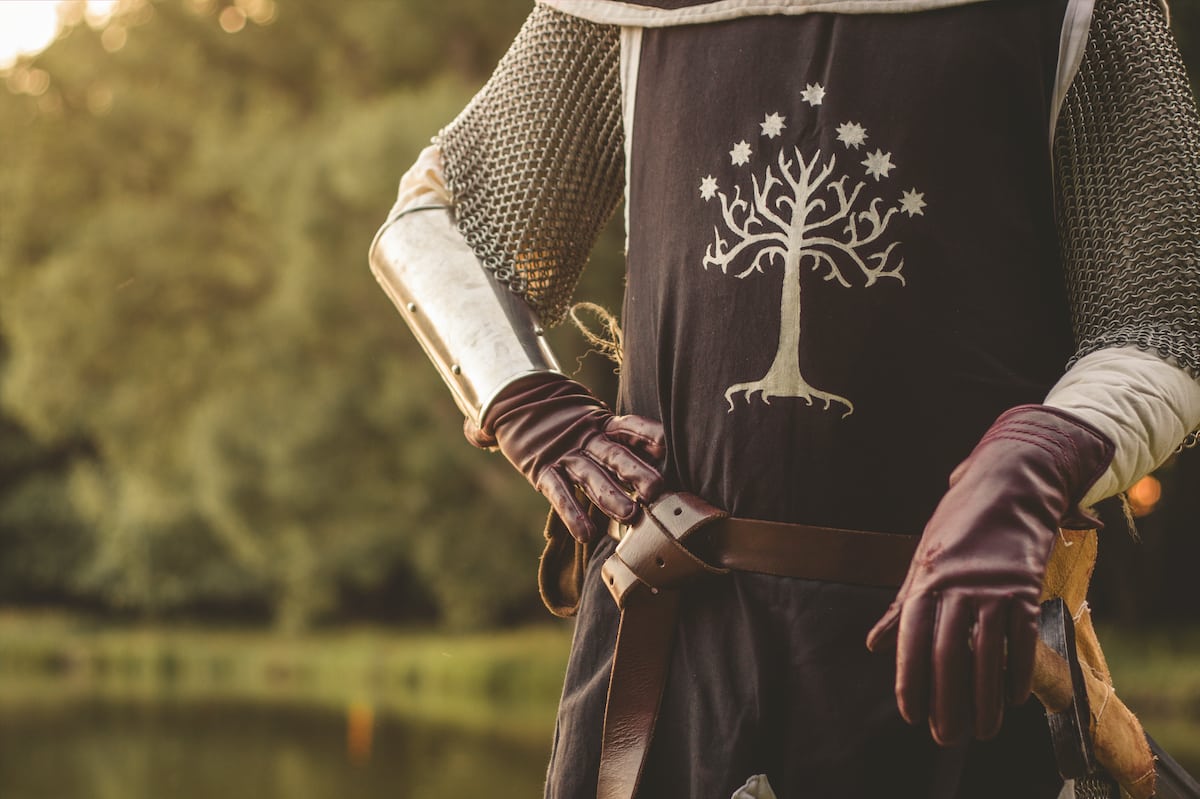 Gloves
Gloves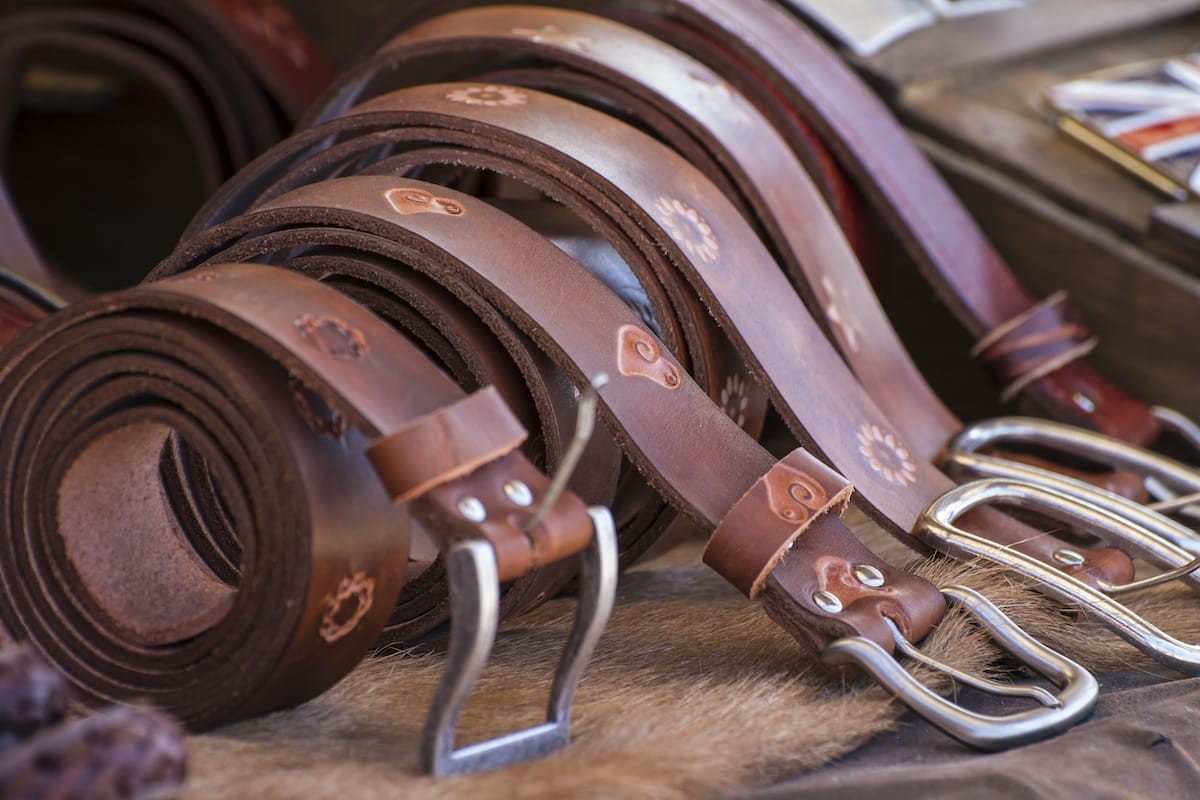 Belts
Belts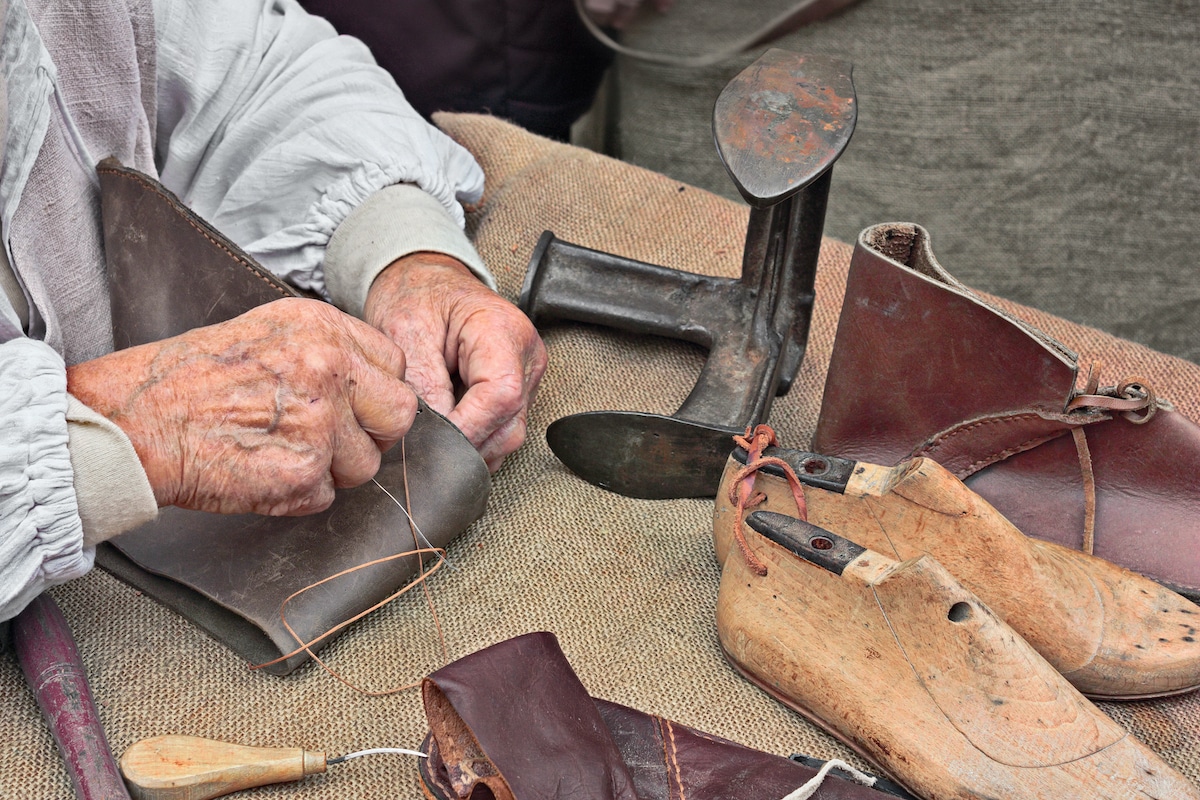 Shoes
Shoes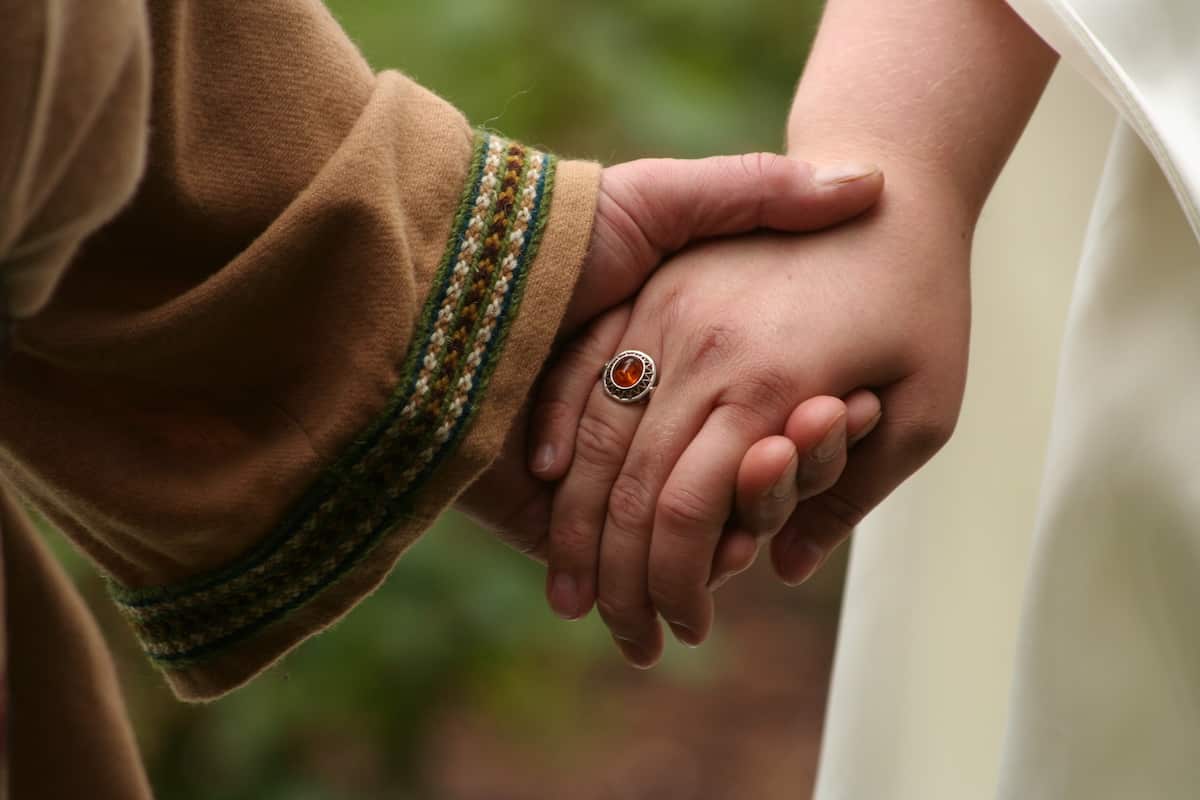 Rings
Rings Necklaces & Pendants
Necklaces & Pendants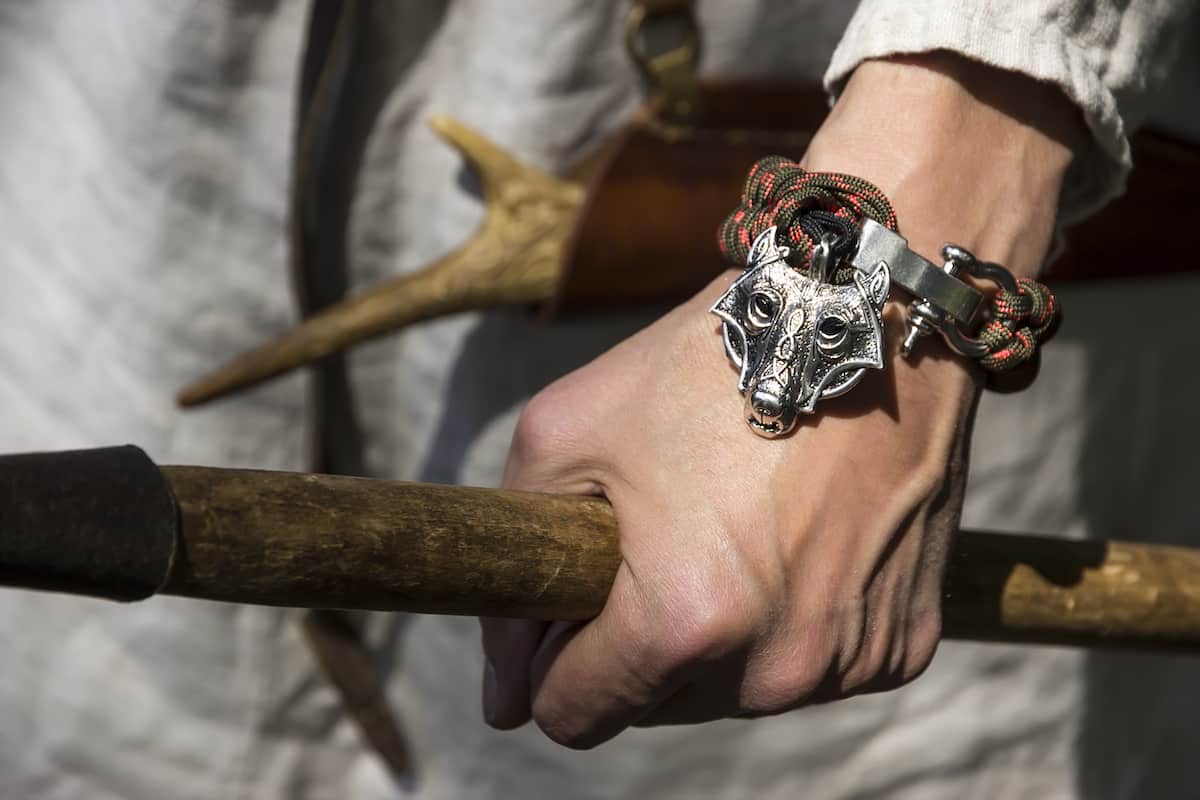 Bracelets
Bracelets